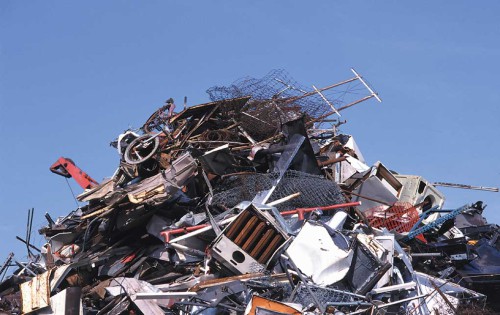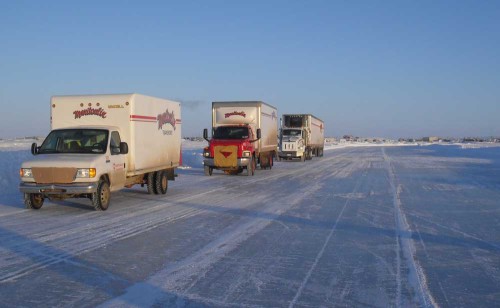MINDEMOYA—The municipality of Central Manitoulin is in a “crisis” situation as the lifespan of its landfills is estimated to be less than two years. This prompted the municipality to host a public meeting to discuss the situation last week, with council imploring members of the public to bring forward any ideas on how waste can be decreased so the landfills can remain open longer.
“I would like to welcome all of you here tonight for this very informal public meeting to discuss our landfill situation,” stated Reeve Gerry Strong at the meeting held last week. “We are in a bit of a crisis as we have reached the end of capacity of our dumps.”
“We want to inform members of the public tonight as this is a significant money issue as well,” said Mr. Strong, noting, “council has not made any decisions on this issue. We want the public input on ways to reduce-divert waste, so that we can lower costs and be more ecologically friendly at our sites.”
“It’s important council receive input from the public before we make some final decisions as to what we are going to do,” said Mr. Strong. “And we will post your comments and input on our municipal website and answer and post as many answers to these questions as we can.”
Denise Deforge, deputy clerk, told the meeting, “as Reeve Strong has said, we are here tonight to discuss the current situation regarding the landfills in Central Manitoulin and to update you on what may be occurring in the near future with our landfills and as well as to our upcoming garbage and recycling contract.”
“As you know Central Manitoulin was amalgamated in March of 1998 from the former Townships of Campbell, Carnarvon and Sandfield. With the amalgamation, Central Manitoulin inherited five landfill sites—Spring Bay, Providence Bay, Mindemoya, Big Lake and Sandfield,” said Ms. Deforge. “The Spring Bay and Sandfield sites are inactive and are no longer being used. The remaining sites, however, are active and very much in use.”
The Providence Bay landfill “is our most active landfill and has a current estimated volume of 34,775 cubic metres,” said Ms. Deforge. It is open to the public on the weekends as it has a garbage and recycling transfer station. This is Central’s only landfill, which also accepts other waste such as tires, mattresses and construction waste.
The Big Lake landfill is also open on the weekends and contains a transfer station for garbage and recycling. Its current estimated volume is 10,300 cubic metres, the meeting was told. The Mindemoya landfill is not open to the public, but is used by the municipality to dump the garbage obtained through its weekly pickup. Its current estimated volume is 29,310 cubic metres.
Ms. Deforge explained, “the issue of garbage, recycling and landfills is always a hot topic, and in fact the municipality spends considerable funds every year in this area. In 2010, Central Manitoulin spent just over $243,000 and in 2011 we spent just over $239,000. This equates for both years to be approximately 3.8 percent of the total municipal expenses for the year.”
It was explained in 2003 that the municipality contracted Earth Tech to complete a waste management plan. Council at the time chose to complete only the recommendations regarding landfill leachate monitoring at the Providence Bay site. In 2005, the municipality began to participate in the Island waste management study. This study lasted for several years and from that study, it was determined that when the local landfill capacity was done, that exporting waste would be more cost effective than developing a new landfill.
“The Ministry of Environment (MOE) has for years now monitored our landfills closely; they do periodic inspections and have now requested that the municipality complete an operational plan for all our landfills. These operation plans are to include closure plans. We are currently in the process of developing a request for proposal for this project,” Ms. Deforge told the meeting.
“In the last four years we have added just less than 12,500 cubic metres of compacted waste to our landfills,” continued Ms. Deforge. “This equates to approximately 60 cubic metres of compacted waste per week. MOE regulations dictate that small landfills have a maximum capacity of 40,000 cubic metres, however this maximum capacity is also limited by such things as property boundaries, and topography. Staff estimates put the lifespan of our landfills at less than two years.”
The municipality has obtained preliminary costing for the transportation and tipping of garbage and this would add an approximate $170,000 to the municipal expenses and equate to an approximate 4.2 percent increase in the municipal portion of the property tax rate, said Ms. Deforge.
“You are talking about the closure of the three landfills in two years. What would the cost be for this?” asked Ken Pearce.
Ms. Deforge noted, “right now we don’t know that figure, it will be part of a closure plan. But it would be a fairly high number.”
“We don’t want the ministry (MOE) to come in and close the landfills,” said Mr. Strong. “We want to keep them operating and used for construction waste, and get around the cost of closure of all sites at once.”
Ms. Deforge pointed out that while the “cost of three closures would be prohibitive, if we can lengthen the time the landfills will remain open we could stagger them being closed. But regardless, right now we are close to the end of the lifespan for all of our landfills.”
Mr. Strong noted there had been an Island waste management committee in place for several years, “but the only real recommendation was for municipalities to truck their waste off the Island. We need your input on how to reduce waste so that we can also reduce the costs involved.”
Under its current recycling services contract, it includes some plastics, glass, and cardboard, the meeting was told. However, when the municipality enters into a new recycling contract, the contract will be taking a lot more materials to be recycled, for instance more plastics.
“No matter what the big cost will be transporting waste off Island,” said councillor Adam McDonald.
Glenn Black noted, “of municipal waste at least one-third is recyclable.” He offered that public education on waste issues is needed, and that there are funding opportunities for municipalities, for instance, to open a small recycling plant or to look at biogas energy waste. How many jobs can this create? Why can’t we deal with the waste ourselves instead of trucking everything off the Island?”
However, Mr. Strong told the meeting, “the Island waste committee looked at this process and didn’t feel there was even enough volumes on the Island to cover the costs. But we can certainly do research on it.”
“When the municipal dump in Massey was closed it cost $400,000—a huge debt for the community,” said one member of the public.
“We certainly can’t afford this type of cost,” said Mr. Strong. “We have to do something because we only have two years capacity for our landfills. Whatever we do there has to be a fair bit of public education geared to it. We are facing an immediate crisis, and we don’t want to have to raise taxes.”
Mr. Strong added that the municipality welcomes any input they receive from the public, and suggestions will be posted on the municipal website, centralmanitoulin.ca, which council will review before making final decisions on what they will carry forward.





